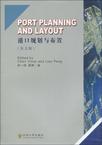港口规划与布置
2009-11
东南大学出版社
陈一梅,廖鹏 编
213
336000
港口是经济全球化过程中十分宝贵的战略资源,是在全球范围内调动资源的物流平台。港口是促进国民经济发展和优化产业布局,提高各国在经济全球化中竞争力的重要基础。《港口规划与布置》是一本关于科学规划和布置港口的专业书。 在经济全球化背景下,各国之间的技术交流与合作频繁。为了提高我国大学生和有关工程技术人员的英语交流能力,在参考了大量国外原版教材基础上,结合我国实例,编写这本英文版教材。 本书主要目的是介绍港口功能和生产运营的基本知识,阐述港口规划与布置的基本原理和方法。全书采用洪承礼教授《港口规划与布置》第二版的结构体系,第一部分是港口规划与布置的基本教学内容,第二部分是附录,供学生扩充知识知识领域时参考。在内容安排上,力求与港口发展的实际和现行规范衔接。重点加强了近年迅速发展的集装箱、LDN/LPG码头、滚装码头布置的介绍。在实例安排上,不仅密切联系中国港口的实际,也适当安排了国外港口的典型例子,以扩大学生的视野。 本书第1,3,4章由陈一梅编写,第2,9章及附录A~F由廖鹏编写,第5,6章由钱芳编写,第7章及附录G由严军编写,第8章由郝建新编写。全书由陈一梅、廖鹏统编审定。在编写过程中得到了河海大学张东生教授、鲁子爱教授,东南大学蒋宗燕教授、徐宿东副教授的热情帮助和支持,顾竣、杜烈武、林强、马丽佳、沈旦等在本书编写过程中参加了部分工作,在此一起表示真诚的感谢! 衷心感谢东南大学陈美华教授审阅英文书稿时所提出的宝贵意见。衷心感谢书中所引用参考文献的各位作者。 由于水平所限,书中缺点和错误在所难免,敬请读者批评指正。
本书主要介绍港口规划与布置所涉及的港口营运、港口规划调查及分析、码头及水域布置、陆域设施、港口发展规划以及环境评价与环境保护等问题。它可作为港口航道与海岸工程专业本科生英文版教科书,亦可作为土木、水利、交通运输类专业的港口课程英文版教材。对从事港口规划、建设、技术管理和港口经营以及从事交通运输综合管理的工程师、经济师们,也是一本有益的专业英文参考书。
1 INTRODUCTION 1.1 The important role of modern ports 1.2 Port and its main components 1.3 Functions of modern ports 1.4 Classification of Ports 1.5 General information on port development2 PORT OPERATION AND SHIPS 2.1 Cargoes 2.1.1 Classification of cargoes 2.1.2 Workings of cargoes inside the ports 2.2 Port hinterland and port throughput 2.2.1 Port hinterland and foreland 2.2.2 Port throughput 2.3 Forecast of port throughput 2.3.1 Introduction 2.3.2 Delphi Forecasting 2.3.3 Time series forecasting 2.3.4 Grey Prediction 2.4 Ships 2.4.1 Introduction 2.4.2 Shipboard measurement 2.4.3 Ship types 2.4.4 The development of maritime ship 2.4.5 Shipping services and networks3 INVESTIGATION AND ANALYSIS FOR PORT PLANNING 3.1 Meteorological conditions 3.1.1 Wind 3.1.2 Rain and Fog 3.1.3 Ice 3.2 Oceanographic conditions 3.2.1 Tide 3.2.2 Waves 3.2.3 Currents 3.3 Estuary conditions4 TERMINAL AND LAYOUT OF QUAYSIDE 4.1 Classification of terminals 4.1.1 By the function 4 1.2 By the layout 4.2 Scale of terminals 4.3 Determination of the optimum berth number 4.3.1 The calculation of optimum berth number 4.3.2 The application of queuing theory 4.4 Some suggestions for port operation management 4.4.1 Berth group 4.4.2 Handling productivity 4.4.3 The timing for increasing port capacity 4.5 Determination of berth scale 4.6 Typical layout for general cargo terminal 4.7 Typical layout for container terminal 4.7.1 Layout for container terminal water area 4.7 2 Layout for container terminal land area 4.8 Typical layout for dry bulk terminal 4.9 Typical layout for Ro/Ro berth 4.10 Typical layout for oil term nal 4.11 Typical layout for LPG/LNG terminal 4.12 Determination of berth surface elevation5 HARBOR AND BREAKWATER 5.1 Introduction 5.2 Water depth 5.2.1 Components of water depth clearance and determinants 5.2.2 Water depth in berthing area 5.2.3 Water depth in approach channel 5.3 Channels 5.3.1 Channel Alignment 5.3.2 Channel width 5.4 Anchorage area and turning area 5.5 Standards for harbor tranquility 5.6 Layout of breakwater 5.7 Aids to navigation6 LANDSIDE FACILITIES 6.1 Port railway 6.2 Road 6.3 Other facilities of port7 PORT DEVELOPMENT PLANNING 7.1 Port planning process 7.1.1 Primary planning 7.1.2 The port distribution planning 7.1.3 The general port planning 7.1.4 The port area planning 7.2 Port demand forecasting 7.3 Port site selection 7.3.1 The port location 7.3.2 The basic types of the port arrangement 7.3.3 The basic requirement for the port site selection 7.3.4 The port area and the urban area 7.4 Port zoning 7.4.1 Port zoning strategy 7.4.2 Port zoning procedure 7.5 Port financial evaluation8 PORT ENVIRONMENT ASSESSMENT AND PRO1 ECTION 8.1 General introduction 8.2 Port environmental impact assessment 8.2.1 EIA of port construction projects 8.2.2 Environmental impact assessment of port planning 8.3 Environmental protection of domain coast 8.3.1 Domain coast environmental protect on 8.3.2 Ecological environment protection9 CHARACTERISTICS OF INLAND RIVER PORTS 9.1 Introduction 9.2 Site selection 9.3 Terminals facilities 9.4 Layout of Inland River Port 9.4.1 Terminal surface and bottom elevation 9.4.2 Layout of the berth lineAppendix A Introduction to EDIAppendix B A Note on Queuing TheoryAppendix C Logistics and Route SelectionAppendix D Vessel Arrival and Berthing Time DistributionAppendix E National Plan for Coastal PortAppendix F Port of New York ant New JerseyAppendix G Special Economic Zone, Free Trade Zone and Free PortReferences
Ro/Ro Handling The principal reason for utilizing a Roll on-Roll off (Ro-Ro) type of operation is that it eliminates the needs for terminal cargo handling equipment, other than tractors, with or without chassis or low-bed yard trailers. Four-wheel-drive tractors are usually used for Ro-Ro work, where they are required to climb and descend ramps, often under wet and slippery conditions. The Ro-Ro tractor generally has a manual gearbox, for maximum power, while "level-ground" tractors normally have automatic gearboxes. Their length must be sufficient to avoid the steep slopes, which are incompatible with freight traffic. At present, roll on/roll off ship-to-shore connection could be classified into two types: fixed shore ramp and adjustable shore ramp. Fixed shore ramp is the fixed incline between the normal quay surface and the outer face of the quay wall on which the shore end of a ship ramp can rest. Adjustable shore ramp is the vertically adjustable roadway, usually hinged at the inshore end and supported independently of the ship near the outer end, that provides an intermediate connection between the shore and the ship, and on which the shore end of a ship ramp can rest. Variations of water level must be considered in selecting the mode of roll on/roll off ship-to-shore connection. When the water level variation is small, a fixed shore ramp is used. When the water level variation is large, or the ramp is too short, the adjusted shore ramp should be used. Figure 4-27(a) shows fixed shore ramp connecting the terminal to the ship. Figure 4-27 (b) shows adjusted shore ramp connecting the terminal to the ship. The length of the adjustable shore ramp shall be such that the maximum operational gradient in normal circumstances does not exceed 10 %.

挺好,学英语,学专业
很不错的一本书,内容详细,文笔细腻,见解独到
是正版 质量很好 做毕业设计很有用
书是正的,快递真是慢,等了10天多了,太慢了